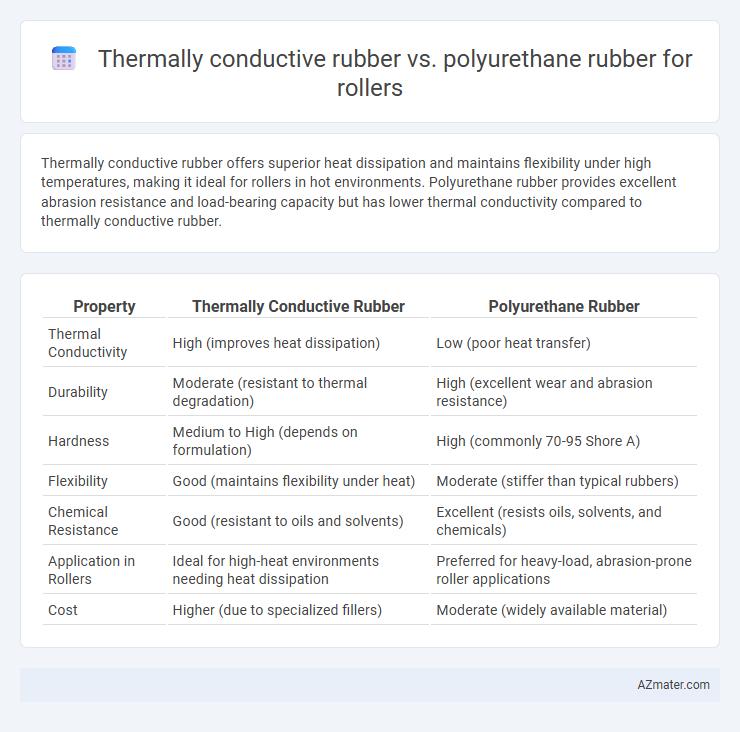Thermally conductive rubber offers superior heat dissipation and maintains flexibility under high temperatures, making it ideal for rollers in hot environments. Polyurethane rubber provides excellent abrasion resistance and load-bearing capacity but has lower thermal conductivity compared to thermally conductive rubber.
Table of Comparison
| Property | Thermally Conductive Rubber | Polyurethane Rubber |
|---|---|---|
| Thermal Conductivity | High (improves heat dissipation) | Low (poor heat transfer) |
| Durability | Moderate (resistant to thermal degradation) | High (excellent wear and abrasion resistance) |
| Hardness | Medium to High (depends on formulation) | High (commonly 70-95 Shore A) |
| Flexibility | Good (maintains flexibility under heat) | Moderate (stiffer than typical rubbers) |
| Chemical Resistance | Good (resistant to oils and solvents) | Excellent (resists oils, solvents, and chemicals) |
| Application in Rollers | Ideal for high-heat environments needing heat dissipation | Preferred for heavy-load, abrasion-prone roller applications |
| Cost | Higher (due to specialized fillers) | Moderate (widely available material) |
Introduction to Roller Materials
Thermally conductive rubber offers enhanced heat dissipation, making it ideal for rollers in high-temperature industrial applications where thermal management is critical. Polyurethane rubber provides superior abrasion resistance and mechanical strength, ensuring durability and longevity in heavy-duty roller environments. Selecting between thermally conductive rubber and polyurethane depends on balancing thermal performance with wear resistance requirements for optimal roller functionality.
Key Properties of Thermally Conductive Rubber
Thermally conductive rubber offers superior heat dissipation with thermal conductivity values typically ranging from 1 to 10 W/m*K, compared to the much lower conductivity of polyurethane rubber, which usually falls below 0.2 W/m*K. This enhanced thermal property ensures efficient heat management in roller applications, preventing overheating and extending the lifespan of machinery components. Additionally, thermally conductive rubber maintains excellent mechanical flexibility and electrical insulation, making it ideal for rollers operating under high-temperature conditions or in electronic environments.
Overview of Polyurethane Rubber
Polyurethane rubber offers superior abrasion resistance and load-bearing capacity compared to thermally conductive rubber, making it ideal for rollers in heavy-duty industrial applications. Its customizable hardness and elasticity enhance durability and operational lifespan under high-stress conditions. Polyurethane also provides excellent resistance to oils, chemicals, and temperature variations, ensuring reliable performance in diverse environments.
Thermal Conductivity: Why It Matters for Rollers
Thermally conductive rubber outperforms polyurethane rubber in heat dissipation, crucial for rollers used in high-temperature or continuous operation environments. Enhanced thermal conductivity prevents overheating, extending roller lifespan and maintaining consistent performance under thermal stress. Polyurethane rubber, while durable, exhibits lower thermal conductivity, making it less effective in applications where efficient heat transfer is essential.
Mechanical Strength Comparison
Thermally conductive rubber exhibits higher mechanical strength compared to polyurethane rubber, making it more resistant to wear and deformation under heavy loads in roller applications. Its enhanced tensile strength and improved elongation at break contribute to greater durability and impact resistance. Polyurethane rubber, while offering good abrasion resistance, generally falls short in maintaining structural integrity under extreme mechanical stress, limiting its effectiveness in high-performance roller environments.
Durability and Wear Resistance
Thermally conductive rubber offers superior heat dissipation, which enhances roller durability by reducing thermal degradation, making it ideal for high-temperature applications. Polyurethane rubber provides excellent wear resistance due to its high abrasion resistance and mechanical strength, extending roller lifespan in abrasive environments. Choosing between these materials depends on specific operational demands, with thermally conductive rubber excelling in heat management and polyurethane rubber outperforming in wear resistance.
Application Suitability: Thermally Conductive vs Polyurethane Rubber
Thermally conductive rubber offers superior heat dissipation, making it ideal for rollers in high-temperature environments such as electronic manufacturing and automotive industries where thermal management is critical. Polyurethane rubber provides exceptional wear resistance and mechanical strength, better suited for heavy-load rollers in conveyor systems and industrial machinery requiring durability and abrasion resistance. Application suitability hinges on balancing thermal conductivity needs with mechanical performance, selecting thermally conductive rubber for heat-sensitive operations and polyurethane rubber for demanding mechanical stress conditions.
Cost Analysis and Economic Considerations
Thermally conductive rubber typically incurs higher initial costs than polyurethane rubber due to specialized filler materials and manufacturing processes enhancing heat dissipation. Polyurethane rubber offers cost-effective production and longer wear life in low-heat applications, reducing total cost of ownership despite lower thermal conductivity. Economic considerations favor polyurethane rubber for standard roller operations, while thermally conductive rubber justifies its premium price in high-heat or heat-sensitive environments, optimizing operational efficiency and equipment longevity.
Performance in Different Operating Environments
Thermally conductive rubber offers superior heat dissipation, making it ideal for rollers operating in high-temperature environments or applications requiring efficient thermal management. Polyurethane rubber excels in abrasion resistance and load-bearing capacity, performing well in environments with heavy mechanical stress or exposure to chemicals. Choosing between these materials depends on the specific demands of the operating environment, balancing thermal conductivity with durability and chemical resistance.
Choosing the Right Rubber Material for Roller Applications
Thermally conductive rubber excels in roller applications requiring efficient heat dissipation, preventing overheating and enhancing durability in high-temperature environments. Polyurethane rubber offers superior abrasion resistance and load-bearing capacity, making it ideal for heavy-duty rollers subjected to mechanical stress and wear. Selecting the right rubber material depends on balancing thermal management needs with mechanical performance demands specific to the roller's operational conditions.

Infographic: Thermally conductive rubber vs Polyurethane rubber for Roller
 azmater.com
azmater.com